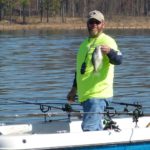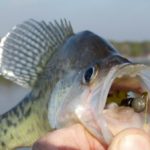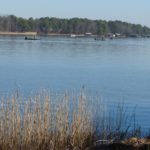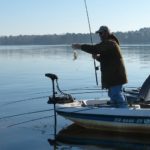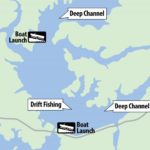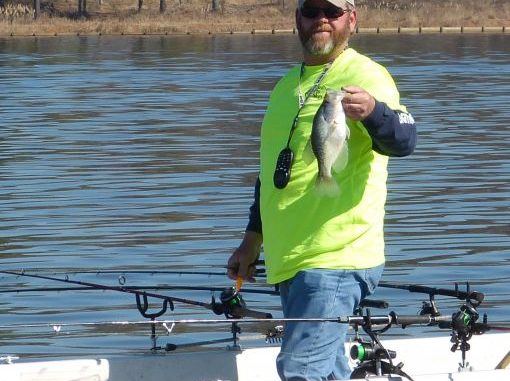
The coldest month of the year means Cypress Bayou Reservoir just east of Benton is the place to be for big crappie. Here’s all you need to know to fill your ice chests.
Do you like to catch crappie? How about watching huge B-52 bombers roar low overhead?
If the answer to these questions is yes, then Cypress Bayou Reservoir is the place for you.
I was introduced to the lake by Greg Hammett, a Cypress Bayou regular who invited me to tag along with him one beautiful February day.
Because the lake was constructed for boating and skiing, there is virtually no visible cover to fish, so it helps to go with someone who knows the location of the reservoir’s honey holes.
“I started fishing here probably 10 or 12 years ago,” Hammett explained. “I used to be a hard-core bass fisherman in the lakes around here, but then I caught a 12-pound bass on Caddo and figured I’d never beat that.
“So now I crappie fish.”
Leaving the ramp, we motored across the lake and then stayed close to the bank for a very specific reason.
“Most of the lake bottom is flat, with a consistent depth of 17 to 18 feet,” Hammett explained. “But the old channel runs along here and it’s 20 to 25 feet deep. Of all the lakes around here — Black Bayou, Cross, Caddo — this one is the deepest.
“Maybe that’s why it’s such a good crappie lake.”
With no channel markers, one could fish Cypress Bayou all day long and never run across this deep channel because it is fairly close to the opposite shore. The same is true for another stretch of deep water that runs near the bank across from the Cypress Bayou Park swimming area.
Hammett finally slowed down and pointed at two boats in the distance.
“Somebody is camped in my favorite place,” he complained. “It’s a good place to fish because there are some pallets there with bamboo in buckets, but the buckets have fallen over.”
I asked if it was common for people to plant brush tops and other structure to create hidden crappie spots.
“People do sink some tops but you can’t always find them when you come back,” he said. “Trolling crankbaits for crappie is popular here, and the crankbait fishermen sometimes snag the tops and pull them around.”
Hammett also pointed out another problem with planting structure.
“If you use PVC to create structure you have to put some wood in it because the PVC won’t show up on your sonar,” he explained. “You can see the bucket but not the PVC.
“I’ve been told it’s because the PVC is the same density as the water.”
Stopping over the channel a couple of hundred yards from the other boats, Hammett succinctly summed up fishing for crappie on Cypress.
“New people on the lake should definitely fish the channel and its deep water from December through February, but in the fall they should try the edge of the channel,” he said. “In the spring, during the spawn, you can ease along the bank and use a spinning rig to throw shiners and jigs under a cork or slow-roll a Road Runner.”
It’s worth the effort because there is some quality fishing available at the lake.
“There’s a lot of good crappie out here, and we’ve caught limits a number of times,” Hammett said. “About three years ago my son caught a 2-pounder slow-rolling a beetle spin. He’s the slow-rolling beetle spin champ.”
Like most Cypress Bayou fishermen, Hammett likes to set out multiple rigs in what is known as a spider rig.
When I said I prefer to hold just two poles so I can feel the “thump,” he chuckled.
“So you’re bipolar,” he said.
Hammett explained that crappie usually hang out close to the bottom, so he sets his rigs to fish about 2 feet above the lake floor.
There was no action in the channel itself, but he quickly caught a nice fish when the boat drifted into shallower water.
“Sometimes they move up shallow and will get right on the edge of the channel,” Hamett said.
That, indeed, seemed to be the pattern on this day, because we frequently caught fish on the edge of the drop.
For the next couple of hours, we drifted over the channel, picking up crappie on shiners and black-and-chartreuse tube jigs.
The fishing was steady, if not furious, but Cypress Bayou has its own unique form of entertainment when things slow down.
Barksdale Air Force Base is just a few miles to the south, and the lake sits on the takeoff flight path. As a result, one often hears a B-52 bomber roar off the runway, and within minutes it soars overhead.
Most everyone seemed to ignore the behemoths, but I found them fascinating and had to watch as each one buzzed the lake.
Later in the morning, Hammett spotted Curtis Wells, another Cypress Bayou regular, who was drift-fishing in the middle of the lake in 18 feet of water.
Wells explained that anglers should not concentrate only on fishing close to the bottom.
“I’m catching them anywhere from 12 feet on down, but the biggest ones have been holding up off the bottom,” he said.
Wells also used a spider rig, but he only fished with shiners. Unlike Hammett, he was tying two hooks per pole and hooked the shiner through the lips rather than under the dorsal fin.
Wells’ system worked well. He had already caught about a dozen quality fish and ended the day with 47 after running out of bait.
Shiners or jigs, bipolar or spider rig — it didn’t seem to matter on Cypress Bayou. They can all fill your ice chest on this crappie factory.
